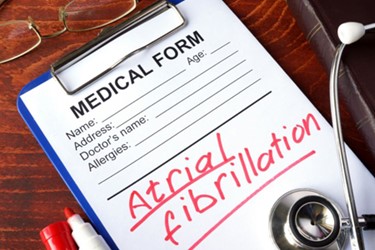BMS-Pfizer Alliance Evaluates AFib Screening And Stroke Connection

By Ed Miseta, Chief Editor, Clinical Leader

In November 2019, the BMS-Pfizer Alliance announced the initiation of a new randomized, controlled study called GUARD-AF. The trial will evaluate whether atrial fibrillation (AFib) screening can ultimately impact the rate of stroke, compared to standard medical care in older individuals in a real-world setting. For this study, the Alliance will recruit elderly individuals, who are at an increased risk for AFib and stroke and are historically underrepresented in clinical trials. An estimated 8 million people in the U.S. will be affected by AFib in 2019.
Jim Rusnak, chief development officer, Internal Medicine at Pfizer, notes stroke is associated with a high degree of morbidity and mortality, and AFib is a significant risk factor for it. “What you may not know is that AFib can be completely asymptomatic and silent,” he says. “Some studies suggest that over 25 percent of patients find out they have AFib only after experiencing an AFib-related stroke. That is unfortunate because if we had screening in place for these patients, there would be an opportunity to put them on a therapy that could reduce their risk of stroke.”

Despite the benefit of screening, no systematic studies on elderly patients has demonstrated that proactive screening has an impact on the incidence of stroke. That is what GUARD-AF is all about. The BMS-Pfizer Alliance, which was formed in 2006, is committed to driving education and awareness about AFib and venous thromboembolism and hopes to address unmet needs around them.
A Randomized Clinical Trial
GUARD-AF is clearly a novel and pragmatic type of clinical trial. It will involve 52,000 patients, both men and women, all of whom are at least 70-years old. The trial will also be randomized, which is typical of pharmaceutical trials.
What makes this trial a bit different from others is that it is very patient-centered. Physicians will be able to treat their patients as they see fit, according to their clinical judgment and practice, as the study protocol does not mandate treatment options.
“Patients come into the study simply by visiting their primary care physician (PCP),” states Rusnak. “The PCP will present the trial to those patients and determine if they have an interest in participating. Patients who express an interest would be provided with an informed consent form. The patients would then be randomized to determine if they receive usual standard medical care treatment or an electrocardiogram (ECG) patch.”
Patients who are randomized for the standard of care treatment are essentially done with the study. There is nothing more they need to do, and their condition will be determined at the end of the study. The group that is randomized to receive the ECG patch will wear it for 14 days. After 14 days they will return and have the patch removed.
“The patients wearing the patch for 14 days will learn the interpretation of the ECG results within five to seven days,” says Rusnak. “If AFib was detected by the patch, each patient’s physician will work with them on a case-by-case basis to determine how to best manage their AFib. Generally, those patients would be put on some type of oral anticoagulation medicine. The physician and patient could opt to use whatever anticoagulation treatment they prefer.”
After that, those patients are also done with their active participation in the trial. The trial will run for two years and the primary outcome measures for both groups of patients will be incidence of stroke and bleeding events that lead to hospitalization.
Easy Entry And Participation
Although this study will require 52,000 patients over the age of 70, Rusnak does not anticipate any recruitment challenges. He notes the study will be easy to get into and will require very little effort on the part of patients and physicians. This is primarily because of the pragmatic study design. Aside from patients needing to be over the age of 70, there are few reasons why a patient would not be able to participate. Individuals known to have AFib, chronic kidney disease or bleeding requiring medical attention over the previous 30 days would be excluded. Those on oral anticoagulants, and with conditions that may risk non-compliance or contraindications are also excluded.
“There is a very low barrier to entry,” says Rusnak. “There is also a low barrier to participation. Only half of the patients recruited will need to wear the patch, and that is only for 14 days. The other 26,000 patients must do little more than sign a consent form. After that it is simply business as usual for everyone involved in the trial.”
Since there is no study drug involved, the launch process was somewhat simplified. GUARD-AF is still a randomized clinical trial, and IRB approval was required in addition to patient consent. But there was obviously no IND required. The patch that will be used in the study is already FDA approved and available on the market.
“This is an interesting trial in that it is really intended to change clinical practice and potentially impact guidelines,” adds Rusnak. “Our ultimate goal is to reduce stroke rates in elderly patients. Hopefully we will be able to see the benefit of that when the study results become available.”
The first patient is expected to be recruited around the end of 2019. The estimated clinical completion date is end of 2021.
